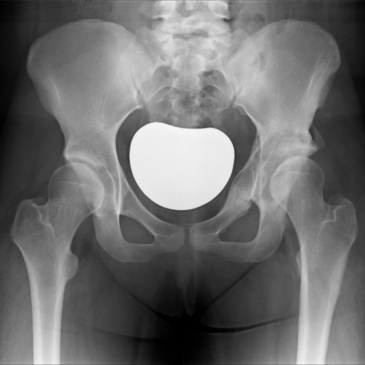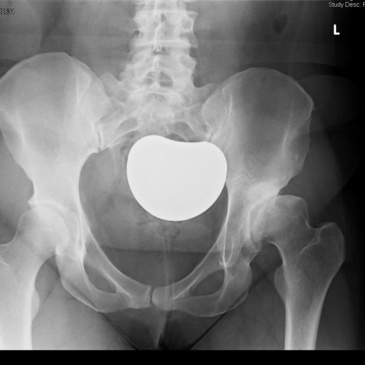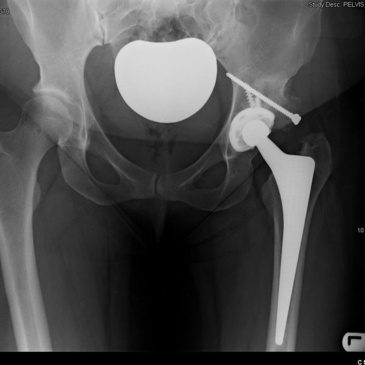Hip Dysplasia
Hip Joint is ball and socket joint. Hip dysplasia is a clinical condition where the hip joint socket is shallow. The shallow socket results in an abnormal loading and there by it leads to early wear and tear changes in the hip joint. The condition if detected and treated at infancy leads to a normal hip joint. In minority of the cases, patients can present with hip dysplasia for the first time in their 2rd, 3rd or 4th decade. The onset of symptoms is a sign of failing hip joint. The symptoms initially can be present during sporting alone. The frequency of symptoms increases with time. In untreated cases, this condition can result in the onset of wear and tear changes (arthritis).
Patients can present with groin pain, limp or clicking. Patients can also complain of dull ache (due to muscle fatigue) around the side of the hip joint.
X-rays help to diagnose the condition (Figure 1). Further evaluation is performed by CT or MRI scans. The treatment depends on the age at diagnosis and severity of the condition. In absence of wear and tear changes, selected patients can be treated by pelvic osteotomy. This procedure preserves the native hip joint and restores the weight bearing portion of the hip joint to near normal. It helps to restore the forces transferred across the joint to near normal status.
Figure 1: Dysplasia of the Both Hips

While there are varieties of techniques to achieve this aim, the most successful technique is periacetabular osteotomy described by Ganz (Bernese periacetabular osteotomy). This technique involves bony cuts made around the socket to free it from the surrounding bone. The socket is then placed in to an optimal position. A period of six weeks of mobilisation with the aid of crutches is advised following this procedure. Figure 2 shows x-rays of the patient who has had Ganz pelvic osteotomy. If the patient has dysplasia with associated wear and tear changes (arthritis) in the hip joint (Figure 3), he or she would benefit from Total hip replacement.
Figure 2: Dysplasia of the Left Hip treated by Ganz Osteotomy.

Figure 3: X-rays of a patient who has had Left Total hip arthroplasty for arthritis associated with hip dysplasia.


Further reading
- A Guide for Adults with Hip Dysplasia [Paperback]
http://www.amazon.co.uk/Guide-Adults-Hip-Dysplasia/dp/0987215205
- International Hip Dysplasia Institute
http://hipdysplasia.org/adult-hip-dysplasia/
Frequently Asked Questions
What is hip dysplasia?
This is a condition associated with inadequate formation of the hip joints. Generally the socket is very shallow. The degree of dysplasia varies from patient to patient.
When do the patients generally present with this condition?
As a new born this condition can be detected and treated adequately with good long term results. However in some cases the dysplasia is very subtle and hard to detect in the childhood. These tend to present during 2nd, 3rd or 4th decades of life.
What is the ideal indication for correction of Hip Dysplasia?
The patients with radiologically confirmed Dysplasia need correction only in the presence of symptoms. It is important to ascertain that they do not have evidence of arthritis. In the presence of arthritis the results of corrective joint preservation surgery are suboptimal.
Is it a must for me to undergo corrective surgery?
It is clear that hip dysplasia results in wear and tear changes in the future and thereby necessitating Hip replacement. If you decide not to have surgery, we would generally advice you to avoid all the impact activities like, running or jogging, and manage your symptoms with pain killers up until the time you need hip replacement. Although hip replacement can relieve your symptoms very well, it has a finite life due to its artificial nature, after which it probably will need changed at least more than once in your life time.
What are the advantages of corrective surgery (Ganz osteotomy)?
The biggest advantage is that, you will have your own hip joint and not an artificial one. There will not be any restrictions on the activities you would like to perform, unless you have wear and tear changes. Women will be able to child bear in a normal way as there is no alteration in the size of the birth canal.
Why not Hip replacement, instead of corrective surgery?
Although Hip replacement is a great pain relieving procedure, it has got finite life due to its artificial nature and it is likely that in your life time, you will need further operations to change the failed replacement. The outcomes after each repeat procedure are not as good as the first time. In addition, patients with hip replacements have to adhere to certain precautions for the rest of their life to prevent complications like dislocation etc, which is not the case if you have your own natural hip joint.
What are the types of surgeries available?
The surgery can involve joint preserving procedure or joint replacement procedure. In presence of arthritis joint preserving procedures do not have good results.
What is done during Ganz (Periacetabular) osteotomy?
Ganz osteotomy is a joint preserving procedure. This procedure does not create any additional joint, but involves repositioning the socket in the most optimum position required for good functioning.
What is minimally Invasive Ganz (Periacetabular) osteotomy?
This technique essentially involves smaller skin incision and the attachment of an important muscle (rectus femoris) is preserved during the procedure. The procedure takes less time to complete. Prof K Soballe from Aarhus, Denmark, has developed this technique.
What are the complications of Ganz (Periacetabular) osteotomy?
This is a major procedure. The complications involve infection, nerve palsy, major bleeding (rare). The nerve palsy generally recovers in few weeks time. There are other complications which can occur and your surgeon should be able to discuss these with you at the time of consultation.
Is it Very Painful and how long will I be in the hospital??
It is a major procedure and hence you are likely to experience some degree of pain immediately after the procedure. However, all the care is taken to give you enough analgesia to aid your symptoms. Generally the patients stay in the hospital for 3-5 days. You will only be sent home, once our team is certain that you are comfortable and mobilising with crutches.
What happens during the postoperative period?
You need great amount of assistance for the first six weeks after surgery. You will be encouraged to use crutches to partially weight bear on the affected side (about 20% body weight). Generally, you will be commenced on to full weight bearing after six weeks, provided the x-rays are satisfactory.
What about the follow-up?
You will be followed up at the clinic, at regular intervals for the foreseeable future. At your follow-up clinical and radiological assessments will be made to assess your progress. Patient reported outcome measures will be recorded to compare your progress with other patients undergoing similar procedure. With informed consent, all the data will be uploaded on to Non-Arthroplasty Hip Register (British Hip Society).
Do I get any physiotherapy?
Yes. You will get physiotherapy after the procedure. This involves assisted exercises in the first six weeks followed by gradually increasing activities after six weeks. You will be encouraged to start hydrotherapy between two- four weeks.
Do I need any assessment by Occupational therapist?
You will be assessed by an Occupational therapist during your preoperative visit. He/she will ensure that your home is suited for you prior to your discharge from the hospital.
When can I get back to reasonable level of activities?
You will be able to start activities after about three-four months. To return to preoperative active life, you might need up to six months. In absence of any wear and tear changes in your joint, you will be allowed to undertake all the activities of your choice once you have achieved adequate range of motion and strength in your hip joint.
What is the success rate of such a procedure?
Published literature shows success rates up to 85-90% in patients with no or minimal arthritis. The failure rates are high if the patients have arthritis in the hip joint.
Do I need any subsequent operation?
You will need a minor procedure to take the screws out. This is done to prevent them coming in the way of any future procedures you may need. This is generally done at the end of a year.
Do I need Hip replacement in later life?
Dysplastic hips are not like normal joints. These patients may develop arthritis in the future even if corrective procedure has been done. This will largely depend upon the degree of wear and tear changes present prior to the corrective procedure. The advantage of the corrective procedure is that, the patients retain their own hip joint and can maintain reasonable level of activity for a foreseeable future.


 About the Glasgow Hip Clinic
About the Glasgow Hip Clinic